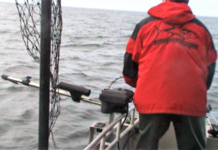
An aggregation of methane ice worms inhabiting a white methane hydrate seen in the Gulf of Mexico, 2102. Studies suggest that these worms eat chemoautotrophic bacteria that are living off of chemicals in the hydrate. Image courtesy of NOAA Okeanos Explorer Program.
Did You Know?
Gas seep faunas vary in species and abundance, depending on the type and amount of seepage. Some species live exclusively with a particular form of hydrocarbon, such as hydrate ice worms. Seep communities are ecologically and economically valuable as sources of food, refuge for an array of species, markers of underlying oil and gas reserves, and potential sources of new commercially valuable bacteria.
For all these reasons, many ocean exploration expeditions target cold water seeps.
When gas molecules are trapped in a lattice of water molecules at temperatures above 0°C and pressures above one atmosphere, they can form a stable solid. These solids are gas hydrates.
Most gas hydrates are formed from methane (CH4). Methane is the simplest hydrocarbon, and is the primary component of the natural gas that we burn for energy. If you hold a hydrate nodule in your hand and light it with a match, it will burn like a lantern wick. There is fire in this ice!
Gas hydrate deposits along ocean margins are estimated to exceed known petroleum reserves by about a factor of three. These hydrate beds leak gases into the water, forming cold seeps on the ocean floor. This hydrocarbon seepage is common on continental margins around the world.
Chemosynthetic communities similar to those found at hydrothermal vents form at cold seeps, using hydrocarbons or hydrogen sulfide for carbon and energy. Seep tube worms, mussels, and clams form two-meter-high bushes over kilometer-sized beds. Most seeps are also characterized by high microbial productivity.
Hydrates influence ocean carbon cycling, global climate change, and coastal sediment stability. Localized meltdowns have caused massive continental slope failure, which can present a geological hazard for shelf oil and gas production. Massive hydrate dissolution events, releasing vast amounts of the greenhouse gas methane, are possible causes of some of the abrupt climate changes seen in the geologic record.
For More Information:
Methane in the Ocean, INSPIRE: Chile Margin 2010
Gas Hydrates Offshore Southeastern United States, Windows to the Deep 2003
It’s a Gas! (pdf, 324 kb)
Animals of the Fire Ice (pdf, 228 kb)
Sign up for the Ocean Explorer E-mail Update List.














